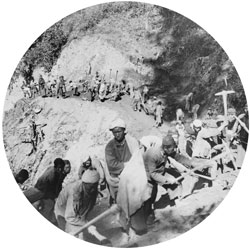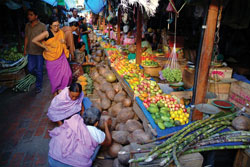Archives
The Look East Policy
All these are vital for a State to be qualified to evolve into a major industrial hub in a country. Notably, Assam also possesses export quality eri and muga as well as mulberry types of silk.
However, the relevant question that may arise in a curious mind is – why is the Centre work – shy when it comes to the very issue of the much – needed economic growth of the resource – rich but fund – deficient North East? This apathy towards this impoverished and under – developed region is resulting in a deep sense of alienation and frustration among the people of the region which can be attributed to either of the two reasons namely – the region’s geographical location as it lies on the far east part of the country while the other cause maybe emanates from the very notion that the region is not a strong constituency in terms of representation of MPs in the Lok Sabha as compared to Uttar Pradesh or Bihar. It may also be because of both these factors.
comes to the very issue of the much – needed economic growth of the resource – rich but fund – deficient North East? This apathy towards this impoverished and under – developed region is resulting in a deep sense of alienation and frustration among the people of the region which can be attributed to either of the two reasons namely – the region’s geographical location as it lies on the far east part of the country while the other cause maybe emanates from the very notion that the region is not a strong constituency in terms of representation of MPs in the Lok Sabha as compared to Uttar Pradesh or Bihar. It may also be because of both these factors.

Whatever be the reason behind the Centre’s soft peddling of the core issue of the region’s rapid development, the fact of the matter is that – should it continue to adopt this attitude towards the North East, the near – normality that is gradually limping back to many parts of the region with a number of insurgent groups including the NDFB (R) and ULFA (A) entering into the ongoing peace talks with the Centre can be disturbed which will not at all be a good portent for Assam or for that matter the parts of the region if not the rest of it, that a better tomorrow poised is just on the cards for some of these States. Maoists who are reported to have already established their bases in some parts of Upper Assam are now presumably on the lookout for an opportune moment to ferment trouble. In Assam, the political atmosphere on the north bank of the Brahmaputra in particular is now a little charged not largely because of the upcoming Lok Sabha polls but because of the Centre’s recent pronouncement of the formation of the one – man GK Pillai Committee coming close on the heels of the bill for a separate Telangana State having been passed in both the houses of Parliament to study and examine the viability of the demand for Bodoland.

This unwise and hasty decision by the UPA Government at the Centre has naturally made Koch Rajbongshis’ hackles rise, more so when we all know that they are spreading the Kamatapur Statehood agitation in the same region for which the Bodo ethnic group is also pitching the demand for their statehood. When both the groups are claiming the same region for their own, the UPA Government’s announcement of the formation of the Pillai Panel must be designed to appease the Bodo groups before the ensuing polls. This is what the All Koch Rajbongshi Student’s Union (AKRSU) has termed as a ‘political gimmick’ and has in fact prompted the AKRSU to cal a 36 hour Assam bandh on the 13th of March in support of a separate Kamatapur State and to demand a Scheduled Tribe status for the Koch Rajbongshi people of Assam. This may encourage disparate ethnic groups to either renew their separate State demands or calls for greater autonomy – a development the entire Brahmaputra Valley reverberated with last year which may once again lead to social unrest in the State.
| Assam’s trade in industrial, horticultural and handloom products with the South East Asian countries would not only have been brisk but would have also been gainful had the Centre reopened the historic Stilwell Road at Ledo in Assam |
The periodic agitation for Statehood or greater autonomy by these ethnic groups which is attributable to the slower pace of economic development in the State however will subside once the much – vaunted Look East Policy starts off. This is the public impression about it. There is no denying the fact that the answer to rapid economic growth and development lies in bringing about greater access to this region in the form of opening its routes towards the neighbouring South East Asian nations such as Singapore, Thailand, Malaysia, Indonesia and China in particular.

Apparently, keeping this point in mind, the Look East Policy was initiated as far back as July 1991 during the tenure of the then PV Narasimha Rao Government at the Centre, shortly after the kick – starting of the country’s economic structural reforms programme which happen to be the brain – child of the then Finance Minister Dr. Broadly speaking, the number of mills, industries and factories in the entire North East region at present is so minimal that they can easily be counted on one’s fingertips. As on March 31, 1998, there were only 177 industrial units such as paper mills, jute mills, plywood and chemical industries as well as handloom industries, etc of which 128 were in Assam alone. To add to this, some of these industries including those in the handloom and horticulture sectors in the State are passing through a bad patch. There are a couple of reasons which are to blame for them to be turning out into losing concerns. One of these reasons is the high cost of transportation besides the high cost of procuring industrial equipment which has to be paid when purchased from mainland India which lies beyond the barely 20 kilometre wide Siliguri Corridor that links the region with the rest of the country.Manmohan Singh who is now the Prime Minister of the country. One of the reasons for the Policy being formulated The periodic agitation for Statehood or greater autonomy by these ethnic groups which is attributable to the slower pace of economic development in the State however will subside once the much – vaunted Look East Policy starts off. This is the public impression about it. There is no denying the fact that the answer to rapid economic growth and development lies in bringing about greater access to this region in the form of opening its routes towards the neighbouring South East Asian nations such as Singapore, Thailand, Malaysia, Indonesia and China in particular. Apparently, keeping this point in mind, the Look East Policy was initiated as far back as July 1991 during the tenure of the then PV Narasimha Rao Government at the Centre, shortly after the kick – starting of the country’s economic structural reforms programme which happen to be the brain – child of the then Finance However, the question is – Has the North East or any constituent State of the region, say Assam, gained in Arguably, the North East region of India is much closer to South and South East Asia than it is to mainland India.To say more precisely, the region shares 98 per cent of its borders with these countries and just 2 per cent with the rest of India. It is widely acknowledged that the region’s aboriginals’ past affinities with the people of countries like Myanmar, Thailand, Laos and China will make its products easily acceptable to them in the event of a greater road connectivity. However, the absence of such connectivity till date has essentially triggered an international barrier which in turn led to the closure of the region’s trade and commerce which had existed during the pre – partition days.terms of its economic development in the past 22 years of the implementation of the Look East Policy? If we do assess whether Assam has at all been a beneficiary of the Policy, it will be seen that if the State has gained anything over the decades, it will be much too meagre to contribute to a turnaround in its almost gloomy economic scenario. Gainful business is possible for Assam or for any other State in the region if there is a great Asian highway connecting the South Asian Association for Regional Cooperation (SAARC) and Association of Southeast Asian Nations (ASEAN).Minister Dr. Manmohan Singh who is now the Prime Minister of the country. One of the reasons for the Policy being formulated was to enable the land – locked North East part of India to make its presence felt in the global free trade regime for engagement in international markets for profits. This is why it was hailed by many a mainstream economic analyst in the country as what was termed ‘a unique proposition’ in the post – cold war phase of world history.
| However, the question is – Has the North East or any constituent State of the region, say Assam, gained in terms of its economic development in the past 22 years of the implementation of the Look East Policy? |
Handloom and handicrafts are an integral part of the region’s tradition and culture. The region accounts for 66per cent of the country’s total looms. Ironically, the handloom industry is gradually losing its commercial potential with its high quality variety or a few products like hand – woven silk of Sualkuchi despite the huge global demand for them because of the lack of attention and cheap imitation of these items by unscrupulous traders from outside the region. Assam’s trade in industrial, horticultural and handloom products with the South East Asian countries would not only have been brisk but would have also been gainful had the Centre reopened the historic Stilwell Road at Ledo in Assam linking Kumning, the capital of China’s Yunan province to the State via Myitkyina in Myanmar. Unfortunately, the Centre has decided to put the reopening of this historic road on hold, evidently on security grounds which is not at all convincing keeping in mind the low ebb of the insurgency movements of the North East region at present.

The Look East Policy is a panacea to the continuous flight of a huge amount of money by the region in buying industrial equipment and items of daily consumption from the Indian heartland. Its initiation for the North East will, as stated earlier, provide the region as well as the remaining States of our country with enormous opportunities for entering into free trade with the neighbouring countries and thereby be engaged in business for profits. Unfortunately, the Policy has still remained a mere document for the region. Indeed, its economic prospects can be brightened if the ongoing projects, trilateral highway connecting India, Myanmar and Thailand and a great Asian highway linking SAARC and ASEAN are executed sooner rather than later.

